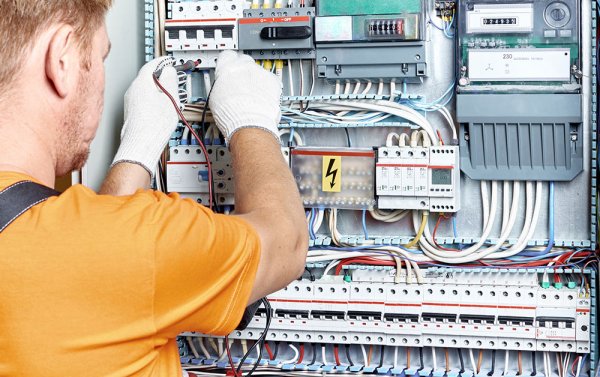Ensuring electrical safety during the installation of electrical installations
Electrical safety requirements apply not only to the design of the equipment, but also such requirements are included in the technical documentation for the installation, repair and dismantling of the equipment.
Requirements for the installation of electrical installations are contained in the PUE (Rules for Electrical Installation).
The main defect in the installation of electrical installations (from the point of view of safety) is the incorrect assembly of electrical circuits. Such defects can occur not only at the stage of initial installation of electrical installations at the place of operation, but also during operation itself (including during repair and testing of equipment).
Installation (and dismantling) defects account for one in three industrial electrical failures. About 50% of them are in agriculture, construction and electricity.
In some sectors of the economy (trade and catering enterprises, electrical and mining industries, educational institutions), electrical injuries due to assembly and disassembly defects reach 45-60% of the number of injuries in this industry. The main contingent of victims are workers from non-electrical professions — tractor drivers, locksmiths, animal breeders, drivers, bricklayers, support workers.
Often an installation defect is not the only cause of an accident. It is accompanied by violations of safety rules: work with unreleased voltage, non-compliance of work with the task, failure to use personal protective equipment, etc. But sometimes these violations are also associated with an installation defect.
Therefore, by improving the quality of installation and the culture of operation of electrical devices, it is possible to reduce the number of violations of safety rules.
The proportion of electrical injuries caused by defects in the installation of electrical circuits of various electrical installations can be estimated from statistical data. In some installations, electrical injuries due to installation defects reach almost 90% of the number of injuries in installations of this type (with an average level of 38.2%):
- Heating elements — 89.5%;
- Electrical wiring — 76.5%;
- Electric tool — 75.5%;
- LEDs — 75.0%;
- Welding machines — 71.3%;
- Mobile equipment with electric drive — 66.8%;
- Cable lines — 55.6%;
- Electric elevators — 53.5%.
The main defect in the installation of electrical receivers, especially mobile ones, is their incorrect connection to the network: connecting several electrical receivers to one switching device or to the network terminals of the device, using wires of inappropriate brands, using extension cords with plugs at both ends of the wire etc.
A typical defect in the installation of electrical wiring is the laying of unprotected wires in accessible places - on the ground, ceilings, above roofs, balconies, on the outer surfaces of pipelines, on plinths, etc.
On construction sites, you cannot do without temporary power networks. Meanwhile, the necessary attention is not paid to the construction and functioning of such networks. This makes it difficult to develop power supply schemes for facilities under construction, determine the optimal conditions for laying wires, create suitable equipment, cables, etc.
Sometimes during operation it is necessary to transfer the engine power from one panel to another, install an additional device, etc. After completing the specified changes, they forget to reflect them on the diagram, rearrange the shipping labels. As a result, staff become disoriented and make mistakes that often lead to accidents.
It is equally dangerous to dismantle the unit, leaving the electrical wiring in place.
Machines and apparatus of the open type must be installed in inaccessible places or fenced. But even today you can find power units, electric motors, transformers with live parts accessible by touch.
On the other hand, it is not safe to use devices located far from control objects or in inconvenient places.
Electrical injuries still occur due to the placement of higher voltage conductors under lower voltage conductors or phase conductors under zero voltage.
The considered defects in the assembly and disassembly of electrical devices are mainly due to non-compliance with the requirements of the current regulatory documents for the construction, commissioning and subsequent maintenance of these devices.
Most violations of rules and regulations are explained by the careless attitude of workers towards the work assigned to them. Some requirements of the rules are not met due to the lack of equipment, cable products of the appropriate type, flaws in the design of the equipment, lack of electrical services of small enterprises and construction sites with qualified personnel, etc. Many injuries can be prevented by increasing the factory readiness of electrical installations.

